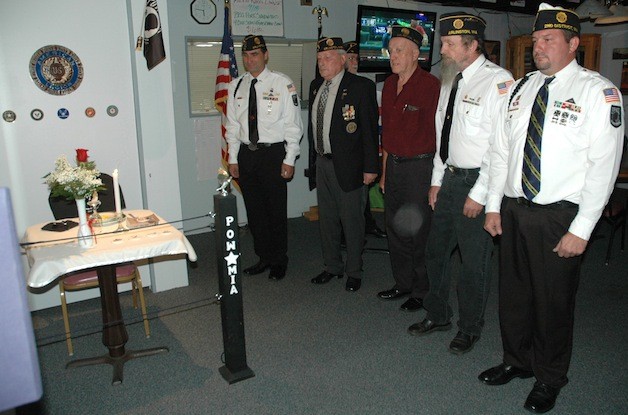ARLINGTON — The Arlington American Legion Post 76 Lounge has already had its POW/MIA table on display for more than a year.
While its setting has figured into the Legion’s commemorations of Memorial Day and Veterans Day, post member and Vietnam veteran Marty Cress wanted to make that ceremony its own event.
The afternoon of Sept. 18 saw the Legion invite the public to observe its first independent POW/MIA ceremony. Cress, who serves as the post’s POW/MIA chairman, thanked the Legion Lounge for maintaining the table even during the months between such ceremonies.
“They make sure the salt and slices of lemon on the plate are fresh and clean, and they refrigerate the rose each day, replacing it with a fresh rose each week,” Cress said, noting that plastic roses tend to get dusty. “It’s a reminder that our enduring peace has been paid for through the bitter personal sacrifice of those who were deployed to places they’d often never heard of, and endured the agonies of pain and depravation in internment.”
Although troops who were prisoners of war and missing in action became an especially prevalent concern in the wake of Vietnam, Cress stressed that the POW/MIA flag and ceremony are intended to honor all American service members who remain missing from the military’s ranks.
“We call them comrades, and brothers and sisters in arms,” Cress said.
As Cress explained, the table is small and set for one, to remind us of the frailty of one prisoner, while the table’s square top signifies that America will search “the four corners of the earth” for its missing military members. The white tablecloth shows the purity of the service members’ intentions, while the red rose stands for the blood they’ve shed for their country.
“The ribbon tied to the vase denotes that we bear witness and demand a proper accounting,” Cress said, as members of the Arlington Legion, Auxiliary and Sons of the Legion placed each item on the table.
Cress further elaborated that the napkin and silverware are reflective of simple luxuries that POWs and MIAs cannot take for granted, while the lemon symbolizes their bitter fate, and the salt their tears.
“We long for answers after decades of uncertainty,” Cress said. “The glass on the table is inverted, because they cannot drink a toast with us. The candle is lit, to illuminate their way home.”
A Bible was then placed on the table, in honor of the strength that such service members gain from their faith and their country, while the chair’s emptiness stands for all POWs and MIAs.
Representatives of each branch of service stepped forward as Cress called out their numbers of POWs and MIAs — 518 for the Army, 360 for the Navy, 511 for the Air Force and 206 for the Marine Corps. Although the Coast Guard had no POWs or MIAs, Cress added that their ranks included troops who were killed in action in Vietnam.
Dorine Delancy then offered a tribute to the POW/MIA flag, designed by Newt Heisley in 1972 for the National League of Families of American Prisoners and Missing in Southeast Asia. Heisley based the flag’s image of a man in captivity on his own son, then 24 years old and in the Marines.
“Heisley recalled his own military experience, and realized that he could have been forgotten, if he were taken prison,” Delancy said. “For that reason he included the message, ‘You are not forgotten.'”
The POW/MIA flag flew over the White House, and in 1989, it was installed in the capitol rotunda, making it the only flag besides the U.S. flag to do so in both cases.
“Don’t remember these people as ghosts of the past,” Cress said. “Remember them as comrades. They swore on the same faith and allegiance as all of you.”








